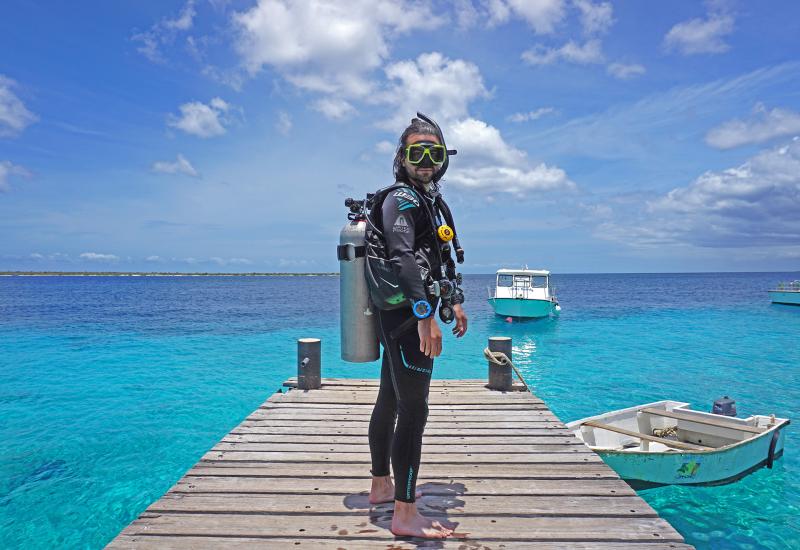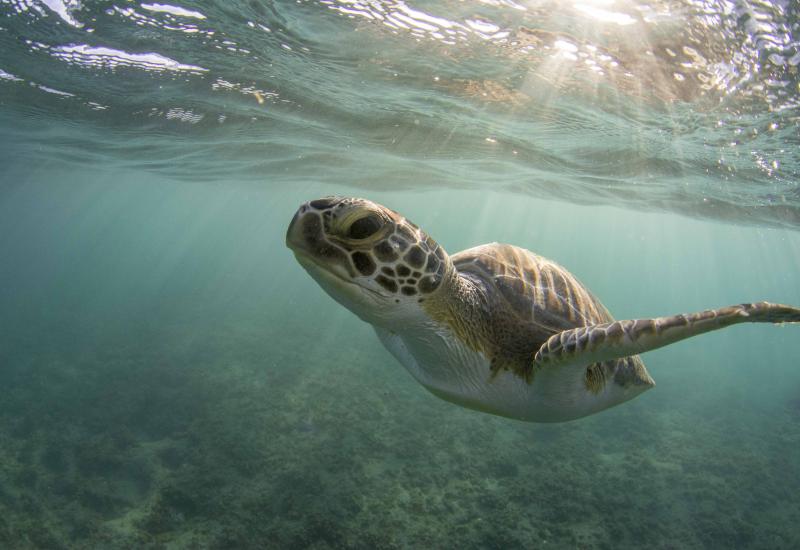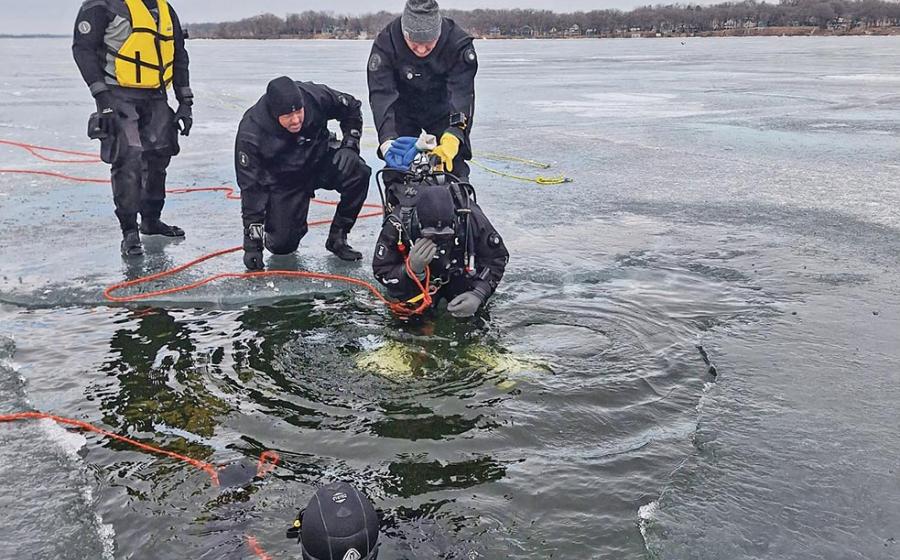Ask An Instructor - November 2007
November 2007
By Mike Ange
Q: On the first few days of most dive trips, I have trouble equalizing while descending, but by about the fifth day, I can usually descend without trouble. I clear my ears every few feet as I descend and drink plenty of water. I've tried vitamin C tablets and even nose drops. Is there anything else I can do to make the first few days of diving easier?
A: It sounds as though your ears need some exercise. A significant number of divers have problems equalizing because the shape and position of their Eustachian tubes make it hard for air to pass through from the throat to the middle ear. For some divers, these tubes are always blocked, requiring extra work every time they equalize. For others, a few days of stretching can open the tubes up and allow normal equalization. Because your problem improves toward the fifth day, you probably fall into the second category. You can do a little pre-dive conditioning by performing the Valsalva maneuver (pinching the nose and blowing gently against the blocked passage) several times a day starting a couple weeks before your next dive trip. Some people say they can feel their ears pop when they do this, but as long as you feel slight pressure in your ears, you're doing fine. Don't force it; just like equalizing during a dive, gentle and often is the way to go.
There are some in-water techniques you can try as well. As soon as you feel discomfort (prior to actual pain) while descending, go back up until all the pressure is gone. Then, as you equalize, stretch your Eustachian tubes by tilting your head to the side opposite the problem ear. If you're having trouble in both ears, do one side, then the other. You can also try wiggling the jaw from side to side or forward and backward while equalizing. If you still have equalization problems after trying all these, an evaluation by an ear, nose and throat doctor may offer a more specific explanation. As a final note, it's best to avoid medications (even over-the-counter ones) when diving unless you've first cleared them with a doctor knowledgeable in hyperbaric medicine.
Q: On a recent dive trip, my divemaster scheduled a 1 p.m. dive on a 90-foot wreck. I also wanted to do the 9 a.m. dive, so he insisted I go deeper than 90 feet in the morning if I wanted to do the afternoon dive. I know it's preferred that the first dive is the deepest, but why build up any more nitrogen than necessary? To avoid any problems, I initially dropped to 92 feet on the first dive then spent the rest of my time at 60 to 40 feet. Was he correct that the first dive must be deeper than the second?
A: The so-called "deepest dive first rule" is a standard dating back to the days when dive tables were the only method of tracking decompression profiles. In reality, the rule is rooted more in practicality than in physiology. When you dive using tables and make the deepest dive second, the allowed bottom time on the second dive is so reduced by the residual nitrogen that it is impractical to make the dive. Here's an example using the U.S. Navy Dive Table: A dive to 92 feet for 22 minutes leaves you a G diver. A two-hour surface interval moves you into group D with 24 minutes of residual nitrogen time, allowing you 36 minutes on a second dive to 60 feet.
A reverse profile is quite different. A 60-foot dive for 40 minutes puts you in group G. A two-hour surface interval makes you a D diver with 14 minutes of residual nitrogen time. The no-decompression limit at 100 feet is only 25 minutes, so after subtracting your residual nitrogen time, you'll only have 11 minutes at depth-if you push the tables to the max. A dive this short is hardly worth the boat ride!
Dive computers track nitrogen loading in real time, so running this profile on a dive computer that allows reverse profiling (not all do-check your owner's manual) would deliver a somewhat more liberal result, but based on some quick research, you can still expect a reverse profile to substantially shorten the time of your second dive. Is it safe to make a reverse profile dive? I found very little research on the topic, and like most dive leaders tend to err on the side of caution, relying on the standard that has kept divers safe for decades.
Q: When diving with nitrox and carrying a "bailout" bottle (specifically, a Spare Air), does the bottle have to be filled with the same nitrox?
A: No. The benefit of nitrox is the reduced nitrogen loading during the dive. You will take on nitrogen faster if you switch to air at depth, but a bailout bottle is an emergency gas supply intended for making a safe, immediate ascent. In any emergency you should terminate the dive as quickly and safely as possible. As you ascend, the decreasing pressure will reduce the rate that nitrogen dissolves into your system, offsetting the gas switch. More important, the time it takes to go up should be relatively short, making the ascent irrelevant to the decompression profile.
Q: My fiancee is claustrophobic and had trouble getting certified. She did fine until she had to take her mask off and put it back on, which made her bolt to the top. She had no problem letting water in her mask and clearing it, but removing it and putting it back on was just too much. Any suggestions?
A: Mask-clearing issues, including anxieties induced by flooded or removed masks, are the most common problems that new divers experience. Truly claustrophobic divers will have issues in dark water or on night dives whether the mask is on or off because they feel closed in. This could easily prohibit her from diving at all. Anxiety caused by water on her face or trying to breathe underwater without her mask may be the real issue here, and fortunately, it's an easier problem to overcome. Snorkeling in open water or supervised scuba diving in a pool may help reduce her anxiety. Also, underwater exercises may help. For example, in a swimming pool-supervised by a certified diving leader-she can try going to the bottom without her mask on, keeping her eyes closed and using her hands to maneuver along the pool wall. To avoid inhaling water, she should practice breathing in through her mouth and out her nose with every breath. With this mastered, she can try keeping one hand on the wall and using the other to search for small objects, like a two-pound weight placed within a foot or so of the wall. Finally, she can graduate to swimming across the open bottom of the pool. She should do these skills until she can focus completely on completing the task, not simply staying underwater. Eventually, the anxiety will disappear as she learns to have faith in her equipment and her skills.
Got a question you need answered?
E-mail it to [email protected], or write to Ask An Instructor, 6600 Abercorn St., Suite 208, Savannah, GA 31405.
November 2007
By Mike Ange
Q: On the first few days of most dive trips, I have trouble equalizing while descending, but by about the fifth day, I can usually descend without trouble. I clear my ears every few feet as I descend and drink plenty of water. I've tried vitamin C tablets and even nose drops. Is there anything else I can do to make the first few days of diving easier?
A: It sounds as though your ears need some exercise. A significant number of divers have problems equalizing because the shape and position of their Eustachian tubes make it hard for air to pass through from the throat to the middle ear. For some divers, these tubes are always blocked, requiring extra work every time they equalize. For others, a few days of stretching can open the tubes up and allow normal equalization. Because your problem improves toward the fifth day, you probably fall into the second category. You can do a little pre-dive conditioning by performing the Valsalva maneuver (pinching the nose and blowing gently against the blocked passage) several times a day starting a couple weeks before your next dive trip. Some people say they can feel their ears pop when they do this, but as long as you feel slight pressure in your ears, you're doing fine. Don't force it; just like equalizing during a dive, gentle and often is the way to go.
There are some in-water techniques you can try as well. As soon as you feel discomfort (prior to actual pain) while descending, go back up until all the pressure is gone. Then, as you equalize, stretch your Eustachian tubes by tilting your head to the side opposite the problem ear. If you're having trouble in both ears, do one side, then the other. You can also try wiggling the jaw from side to side or forward and backward while equalizing. If you still have equalization problems after trying all these, an evaluation by an ear, nose and throat doctor may offer a more specific explanation. As a final note, it's best to avoid medications (even over-the-counter ones) when diving unless you've first cleared them with a doctor knowledgeable in hyperbaric medicine.
Q: On a recent dive trip, my divemaster scheduled a 1 p.m. dive on a 90-foot wreck. I also wanted to do the 9 a.m. dive, so he insisted I go deeper than 90 feet in the morning if I wanted to do the afternoon dive. I know it's preferred that the first dive is the deepest, but why build up any more nitrogen than necessary? To avoid any problems, I initially dropped to 92 feet on the first dive then spent the rest of my time at 60 to 40 feet. Was he correct that the first dive must be deeper than the second?
A: The so-called "deepest dive first rule" is a standard dating back to the days when dive tables were the only method of tracking decompression profiles. In reality, the rule is rooted more in practicality than in physiology. When you dive using tables and make the deepest dive second, the allowed bottom time on the second dive is so reduced by the residual nitrogen that it is impractical to make the dive. Here's an example using the U.S. Navy Dive Table: A dive to 92 feet for 22 minutes leaves you a G diver. A two-hour surface interval moves you into group D with 24 minutes of residual nitrogen time, allowing you 36 minutes on a second dive to 60 feet.
A reverse profile is quite different. A 60-foot dive for 40 minutes puts you in group G. A two-hour surface interval makes you a D diver with 14 minutes of residual nitrogen time. The no-decompression limit at 100 feet is only 25 minutes, so after subtracting your residual nitrogen time, you'll only have 11 minutes at depth-if you push the tables to the max. A dive this short is hardly worth the boat ride!
Dive computers track nitrogen loading in real time, so running this profile on a dive computer that allows reverse profiling (not all do-check your owner's manual) would deliver a somewhat more liberal result, but based on some quick research, you can still expect a reverse profile to substantially shorten the time of your second dive. Is it safe to make a reverse profile dive? I found very little research on the topic, and like most dive leaders tend to err on the side of caution, relying on the standard that has kept divers safe for decades.
Q: When diving with nitrox and carrying a "bailout" bottle (specifically, a Spare Air), does the bottle have to be filled with the same nitrox?
A: No. The benefit of nitrox is the reduced nitrogen loading during the dive. You will take on nitrogen faster if you switch to air at depth, but a bailout bottle is an emergency gas supply intended for making a safe, immediate ascent. In any emergency you should terminate the dive as quickly and safely as possible. As you ascend, the decreasing pressure will reduce the rate that nitrogen dissolves into your system, offsetting the gas switch. More important, the time it takes to go up should be relatively short, making the ascent irrelevant to the decompression profile.
Q: My fiancee is claustrophobic and had trouble getting certified. She did fine until she had to take her mask off and put it back on, which made her bolt to the top. She had no problem letting water in her mask and clearing it, but removing it and putting it back on was just too much. Any suggestions?
A: Mask-clearing issues, including anxieties induced by flooded or removed masks, are the most common problems that new divers experience. Truly claustrophobic divers will have issues in dark water or on night dives whether the mask is on or off because they feel closed in. This could easily prohibit her from diving at all. Anxiety caused by water on her face or trying to breathe underwater without her mask may be the real issue here, and fortunately, it's an easier problem to overcome. Snorkeling in open water or supervised scuba diving in a pool may help reduce her anxiety. Also, underwater exercises may help. For example, in a swimming pool-supervised by a certified diving leader-she can try going to the bottom without her mask on, keeping her eyes closed and using her hands to maneuver along the pool wall. To avoid inhaling water, she should practice breathing in through her mouth and out her nose with every breath. With this mastered, she can try keeping one hand on the wall and using the other to search for small objects, like a two-pound weight placed within a foot or so of the wall. Finally, she can graduate to swimming across the open bottom of the pool. She should do these skills until she can focus completely on completing the task, not simply staying underwater. Eventually, the anxiety will disappear as she learns to have faith in her equipment and her skills.
Got a question you need answered?
E-mail it to [email protected], or write to Ask An Instructor, 6600 Abercorn St., Suite 208, Savannah, GA 31405.










